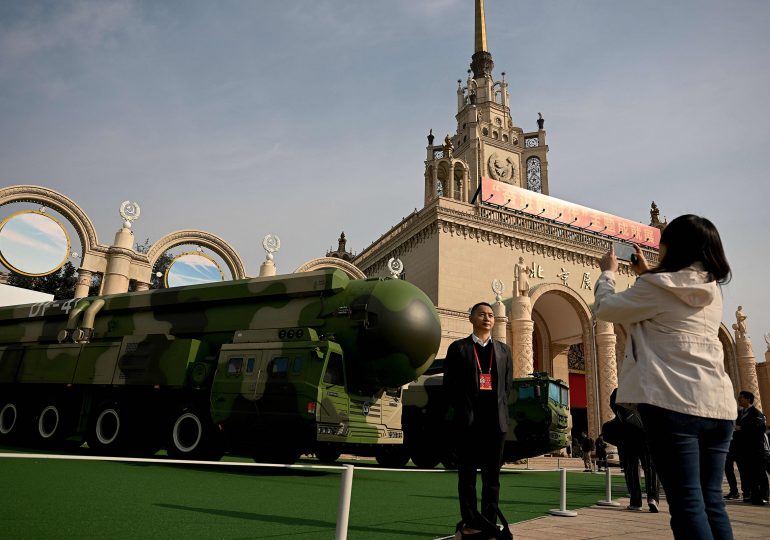America has one of the largest strategic nuclear arsenals in the world—and one of the oldest. The U.S. can deliver nuclear weapons from silos buried deep in the American heartland, submarines plying vast oceans, or bombers conducting global patrols. Nuclear power has underpinned not just America’s security but that of its closest allies for decades. But the U.S. is losing its nuclear edge in ways that profoundly affect Washington’s interests.
[time-brightcove not-tgx=”true”]
Today, the U.S.’ most formidable adversary, China, is growing its nuclear arsenal by rapidly churning out launch platforms and warheads faster than America’s aging forces can be replaced. A revisionist power like China is most effectively deterred when confronted by an opponent with the resolve and capability to balance out their forces in peacetime and, should deterrence fail, deny them victory in wartime. Satellite imagery of China’s nuclear forces shows that this balance is deteriorating.
Read More: Inside the Mission to Modernize America’s Nuclear Missiles
Four years ago, this section of desert in western China was an empty sandscape. Now dozens of missile silos, which can hold the continental U.S. at risk, dot the ground in a pattern visible from space. This scene has played out across western China where once-barren desert stretches have grown into sprawling missile fields. The Pentagon assesses that China has laid down and completed at least 300 new silos—a dramatic expansion from the 20 fixed launchers Beijing operated for decades.
A senior U.S. defense official recently revealed that China has begun loading these silos with intercontinental-range missiles. This is to say nothing of Beijing’s more secure road-mobile systems that can also hold the U.S. homeland at risk but are less vulnerable to preemptive attack. The Pentagon has reported to Congress that China’s intercontinental-range missile launchers, in total, outnumber America’s 400 silos loaded with the 54-year-old Minuteman III. China has thus exceeded the targeting coverage of the obsolescing U.S. land-based capability.
And it’s not just silos that China is constructing. Beijing is also devoting vast resources to expand the reach of its sea-based fleet that houses long-range missiles. Since 2007, China has operated noisy Type 094 submarines that cannot target the continental U.S. from home waters. The Type 094 would have to range deep into the Pacific Ocean just to threaten California—no easy task since the U.S. Navy can easily detect their loud acoustic signatures. But Beijing is currently expanding the capacity of its Bohai Shipyard to crank out a new class of ballistic missile submarines. The Type 096 is expected to be quieter and armed with longer-range weapons to hold the U. S at risk from the safety of coastal waters.
Meanwhile, America’s atrophied shipyards struggle to produce a next-generation ballistic missile submarine, capable of launching missiles and evading satellite reconnaissance. In April, the U.S. Navy announced that the first Columbia-class submarine—initially set for delivery just as Ohio-class submarines begin to reach the end of their service life in 2027—would be delayed 12 to 16 months.
China is also expanding and improving its airborne nuclear options. Beijing recently reassigned a nuclear role to the H-6 bomber, outfitting it with an air-to-air refueling capability to extend its reach in the Asia-Pacific. In May, China released footage of an H-6 conducting a flight test of a new air-launched ballistic missile, which the Pentagon suspects is nuclear-capable. Such a strike option would intensify pressure on Guam, a critical logistical hub that allows the U.S. to defend its Asia-Pacific allies. In late July, Canadian and U.S. air forces intercepted two H-6 bombers conducting joint exercises with Russia near Alaska.
Even more concerning, though, is Beijing’s ongoing development of a long-range stealth bomber. The H-20 is expected to be nuclear-capable and able to strike portions of the continental U.S. To date, the U.S. has not faced the threat of a long-range stealth bomber—let alone one that’s nuclear-capable. China is thus aggressively building out a strategic nuclear triad of land-, sea-, and air-based capability to rival America’s.
Yet Washington is shockingly complacent. Despite two bipartisan commissions recently calling for America’s nuclear revival, neither President Joe Biden nor presidential candidates Vice President Kamala Harris and Donald Trump have drawn significant public attention to China’s breathtaking buildup. This should change.
The U.S. must revamp its rapidly aging arsenal to remain competitive against China—to say nothing of a Russia and North Korea that are modernizing their respective forces. Deterring these proliferating threats requires the immediate uploading of additional warheads on silo-based missiles and an accelerated submarine-building campaign. America’s leaders should make an energetic public case for these measures—or risk the balance of resolve and capability that has preserved great-power peace since World War II.
Leave a comment








